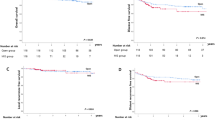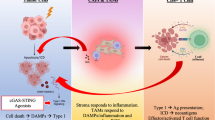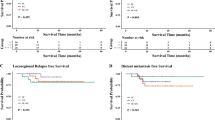Abstract
Mid-low rectal cancer is one of the most common types of rectal cancer and has a poor prognosis. Surgery and chemoradiotherapy are the main treatments for early and advanced rectal cancer with an overall 5-year relative survival rate of only 56.9%. Development of novel antitumor agents is needed. Animal models of disease are indispensable for drug development. The most commonly used animal models of rectal cancer are established by inducing tumors by the subcutaneous transplantation, cecum or peritoneal injection, but not injection in the rectum. Their tumor microenvironment differs from that of rectal tumors in situ, which is hard to precisely simulate the occurrence and development process and drug response of human rectal cancer. In this study, we established orthotopic mouse models of mid-low rectal cancer with primary tumors originating from the rectum, including two models that could simulate the early and advanced stages of the disease, respectively. In the first model, the local primary tumor was restricted to the rectal area of the anal verge by rectal submucosal injection, its growth could be monitored with IVIS live imaging and magnetic resonance imaging. Histological analysis confirmed that the tumor originated from the submucosal layer and then invaded the muscular layer without metastatic tumors. This model may be useful for evaluating drugs for early mid-low rectal cancer in the future. The second model featuring a rectal primary tumor accompanied with abdominal metastases was established via rectal serosal injection. In this model, a large tumor formed at the rectal injection site and then metastasized to the abdominal cavity, reproducing the process from occurrence to metastasis of mid-low rectal cancer, and may be a good tool for the evaluation of drugs for advanced-stage disease. The injection methods used in these models do not require the aid of special colonoscopes, are simple and easy to operate, and have high tumor tumorigenicity and reproducibility. These results suggest that our staged modeling can provide targeted choices for preclinical drug research of mid-low rectal cancer at different stages.
This is a preview of subscription content, access via your institution
Access options
Subscribe to this journal
Receive 12 print issues and online access
$259.00 per year
only $21.58 per issue
Buy this article
- Purchase on SpringerLink
- Instant access to full article PDF
Prices may be subject to local taxes which are calculated during checkout





Similar content being viewed by others
References
Sung H, Ferlay J, Siegel RL, Laversanne M, Soerjomataram I, Jemal A, et al. Global cancer statistics 2020: GLOBOCAN estimates of incidence and mortality worldwide for 36 cancers in 185 countries. CA Cancer J Clin. 2021;71:209–49.
Spaander MCW, Zauber AG, Syngal S, Blaser MJ, Sung JJ, You YN, et al. Young-onset colorectal cancer. Nat Rev Dis Primers. 2023;9:21.
Murphy CC, Sandler RS, Sanoff HK, Yang YC, Lund JL, Baron JA. Decrease in incidence of colorectal cancer among individuals 50 years or older after recommendations for population-based screening. Clin Gastroenterol Hepatol. 2017;15:903–9.e6.
Cheng LJ, Chen JH, Chen SY, Wei ZW, Yu L, Han SP, et al. Distinct prognosis of high versus mid/low rectal cancer: A propensity score-matched cohort study. J Gastrointest Surg. 2019;23:1474–84.
Gaertner WB, Kwaan MR, Madoff RD, Melton GB. Rectal cancer: An evidence-based update for primary care providers. World J Gastroenterol. 2015;21:7659–71.
Gordillo CH, Sandoval P, Muñoz-Hernández P, Pascual-Antón L, López-Cabrera M, Jiménez-Heffernan JA. Mesothelial-to-mesenchymal transition contributes to the generation of carcinoma-associated fibroblasts in locally advanced primary colorectal carcinomas. Cancers. 2020;12:499.
Chen W, Shi K, Yu Y, Yang PP, Bei ZW, Mo D, et al. Drug delivery systems for colorectal cancer chemotherapy. Chin Chem Lett. 2024;35:109159.
Hoeffel C, Mulé S, Laurent V, Bouché O, Volet J, Soyer P. Primary rectal cancer local staging. Diagn Interv Imaging. 2014;95:485–94.
Heo SH, Kim JW, Shin SS, Jeong YY, Kang HK. Multimodal imaging evaluation in staging of rectal cancer. World J Gastroenterol. 2014;20:4244–55.
Das P, Crane CH. Staging, prognostic factors, and therapy of localized rectal cancer. Curr Oncol Rep. 2009;11:167–74.
Li Y, Wang J, Ma XW, Tan L, Yan YL, Xue CF, et al. A review of neoadjuvant chemoradiotherapy for locally advanced rectal cancer. Int J Biol Sci. 2016;12:1022–31.
Benson AB, Venook AP, Al-Hawary MM, Azad N, Chen YJ, Ciombor KK, et al. Rectal cancer, version 2.2022, NCCN clinical practice guidelines in oncology. J Natl Compr Canc Netw. 2022;20:1139–67.
Kiyozumi Y, Akiyoshi T, Mukai T, Hiyoshi Y, Nagasaki T, Yamaguchi T, et al. Lateral local recurrence after total mesorectal excision for mid/low rectal cancer: Study of clinical characteristics and impact of salvage surgery on survival. Br J Surg. 2022;109:904–7.
Nixon NA, Khan OF, Imam H, Tang PA, Monzon J, Li H, et al. Drug development for breast, colorectal, and non-small cell lung cancers from 1979 to 2014. Cancer. 2017;123:4672–9.
Biotechnology Innovation Organization (US). Clinical development success rates 2006-2015. Washington: The Organization; 2016.
Lorenz E, Stewart HL. Intestinal carcinoma and other lesions in mice following oral administration of 1,2,5,6-dibenzanthracene and 20-methylcholanthrene1. J Natl Cancer Inst. 1940;1:17–40.
Nambiar PR, Girnun G, Lillo NA, Guda K, Whiteley HE, Rosenberg DW. Preliminary analysis of azoxymethane induced colon tumors in inbred mice commonly used as transgenic/knockout progenitors. Int J Oncol. 2003;22:145–50.
Tojo M, Miyato H, Koinuma K, Horie H, Tsukui H, Kimura Y, et al. Metformin combined with local irradiation provokes abscopal effects in a murine rectal cancer model. Sci Rep. 2022;12:7290.
Kakiuchi Y, Kuroda S, Kanaya N, Kumon K, Tsumura T, Hashimoto M, et al. Local oncolytic adenovirotherapy produces an abscopal effect via tumor-derived extracellular vesicles. Mol Ther. 2021;29:2920–30.
Wang C, Zhao M, Liu YR, Luan X, Guan YY, Lu Q, et al. Suppression of colorectal cancer subcutaneous xenograft and experimental lung metastasis using nanoparticle-mediated drug delivery to tumor neovasculature. Biomaterials. 2014;35:1215–26.
Mittal VK, Bhullar JS, Jayant K. Animal models of human colorectal cancer: Current status, uses and limitations. World J Gastroenterol. 2015;21:11854–61.
Okumura M, Ichihara H, Matsumoto Y. Hybrid liposomes showing enhanced accumulation in tumors as theranostic agents in the orthotopic graft model mouse of colorectal cancer. Drug Deliv. 2018;25:1192–9.
Alamo P, Gallardo A, Pavón MA, Casanova I, Trias M, Mangues MA, et al. Subcutaneous preconditioning increases invasion and metastatic dissemination in mouse colorectal cancer models. Dis Model Mech. 2014;7:387–96.
Gremonprez F, Willaert W, Ceelen W. Animal models of colorectal peritoneal metastasis. Pleura Peritoneum. 2016;1:23–43.
Qiu C, Li YQ, Liang X, Qi YX, Chen YY, Meng XK, et al. A study of peritoneal metastatic xenograft model of colorectal cancer in the treatment of hyperthermic intraperitoneal chemotherapy with raltitrexed. Biomed Pharmacother. 2017;92:149–56.
Hung KE, Maricevich MA, Richard LG, Chen WY, Richardson MP, Kunin A, et al. Development of a mouse model for sporadic and metastatic colon tumors and its use in assessing drug treatment. Proc Natl Acad Sci USA. 2010;107:1565–70.
Donigan M, Loh BD, Norcross LS, Li S, Williamson PR, DeJesus S, et al. A metastatic colon cancer model using nonoperative transanal rectal injection. Surg Endosc. 2010;24:642–7.
Chen YC, Miao ZF, Yip KL, Cheng YA, Liu CJ, Li LH, et al. Gut fecal microbiota transplant in a mouse model of orthotopic rectal cancer. Front Oncol. 2020;10:568012.
Sun LB, Xing JP, Zhou XP, Song XY, Gao SH. Wnt/β-catenin signalling, epithelial-mesenchymal transition and crosslink signalling in colorectal cancer cells. Biomed Pharmacother. 2024;175:116685.
Hsieh RC, Krishnan S, Wu RC, Boda AR, Liu A, Winkler M, et al. ATR-mediated CD47 and PD-L1 up-regulation restricts radiotherapy-induced immune priming and abscopal responses in colorectal cancer. Sci Immunol. 2022;7:eabl9330.
Tommelein J, De Vlieghere E, Verset L, Melsens E, Leenders J, Descamps B, et al. Radiotherapy-activated cancer-associated fibroblasts promote tumor progression through paracrine IGF1R activation. Cancer Res. 2018;78:659–70.
Yang J, Wei YF, Gao L, Li ZJ, Yang X. Thermosensitive methyl-cellulose-based injectable hydrogel carrying oxaliplatin for the treatment of peritoneal metastasis in colorectal cancer. J Mater Chem B. 2024;12:5171–80.
Lang D, Ciombor KK. Diagnosis and management of rectal cancer in patients younger than 50 years: Rising global incidence and unique challenges. J Natl Compr Canc Netw. 2022;20:1169–75.
Kosinski L, Habr-Gama A, Ludwig K, Perez R. Shifting concepts in rectal cancer management: a review of contemporary primary rectal cancer treatment strategies. CA Cancer J Clin. 2012;62:173–202.
Lanza G, Messerini L, Gafà R, Risio M. Colorectal tumors: The histology report. Dig Liver Dis. 2011;43:S344–55.
Qu JJ, Kalyani FS, Liu L, Cheng TL, Chen LJ. Tumor organoids: Synergistic applications, current challenges, and future prospects in cancer therapy. Cancer Commun. 2021;41:1331–53.
Lai YX, Wei XR, Lin SH, Qin L, Cheng L, Li P. Current status and perspectives of patient-derived xenograft models in cancer research. J Hematol Oncol. 2017;10:106.
Acknowledgements
This study was supported by the National Natural Science Foundation of China (U21A20417, 31930067); the Natural Science Foundation of Sichuan Province (2024NSFSC0046); the Sichuan Science and Technology Program (2022YFS0333); the 1·3·5 Project for Disciplines of Excellence, West China Hospital, Sichuan University (ZYGD18002); and the Post-Doctor Research Project, West China Hospital, Sichuan University (2018HXBH066). The schematic illustrations in the figures were created entirely or partially via BioRender (biorender.com). The magnetic resonance imaging study was performed with the help of Huai-qiang Sun and Sheng-lan You at the Animal Imaging Core Facility at West China Hospital, Sichuan University.
Author information
Authors and Affiliations
Contributions
ZYQ, WC and KS contributed to the study concept and design. WC performed the experiments, interpreted the data, and wrote the manuscript. DM, MP, ZWB, HZD, PPY, QT, LPY, YYW, JFL and LLP assisted in conducting the investigations. KS and ZYQ helped with the writing of the manuscript. ZYQ obtained funding for the study and led the study. All of the authors approved the final version of the article.
Corresponding author
Ethics declarations
Competing interests
The authors declare no competing interests.
Supplementary information
Rights and permissions
Springer Nature or its licensor (e.g. a society or other partner) holds exclusive rights to this article under a publishing agreement with the author(s) or other rightsholder(s); author self-archiving of the accepted manuscript version of this article is solely governed by the terms of such publishing agreement and applicable law.
About this article
Cite this article
Chen, W., Shi, K., Mo, D. et al. Development of orthotopic mouse models for mid-low rectal cancer. Acta Pharmacol Sin 46, 1772–1781 (2025). https://doi.org/10.1038/s41401-025-01489-8
Received:
Accepted:
Published:
Issue date:
DOI: https://doi.org/10.1038/s41401-025-01489-8



